Fare evasion is a drain on the public transport network. But sometimes the “tough on fare evasion” rhetoric isn’t matched by practical, non-confrontational approaches to reduce it.
Across the public transport network, there is a mix of strategies. On Melbourne’s train network as on many big busy systems, there are too many passengers to check all tickets manually, so other means such automated fare gates come into play.
Before Myki, and before Metcard, there were “manual” fare gates. At central city stations, paper tickets would be visually checked by staff as you passed through a gate/past a booth. Checking an individual ticket was quicker, but this required huge numbers of staff to cover peak times. On weekends in the 80s and early 90s there were usually minimal staff on duty, often resulting in queues to enter and exit places like Flinders Street Station even at relatively quiet times.
And suburban stations had physical gates, which not only stopped people running in and trying to catch a departing train, but also enabled station staff to do ticket checks. By the late-80s, staff cuts meant this became more and more rare, and they were all removed (or opened permanently) during the 90s. (In fact, just before Metcard arrived in the 90s, station staff were often so scarce it was impossible to buy a train ticket at some times of day.)
How many trips go through gates today?
Automated fare gates were initially installed with Metcard at central city stations only, but they’ve gradually spread.
Nowadays the policy is that all Premium Metro stations (staffed first to last train) have gates installed when they are built or rebuilt. By my reckoning, that means that the number of stations with gates has grown to 25:
- Flinders Street (apart from an ungated entry/exit at Elizabeth Street sometimes opened at peak times due to crowding)
- Southern Cross
- Flagstaff
- Melbourne Central
- Parliament
- Richmond
- South Yarra
- North Melbourne
- Bayswater
- Bentleigh
- Box Hill
- Camberwell (platforms 1+2 only)
- Caulfield (platforms 2+3 only)
- Dandenong
- Footscray
- Frankston
- Glen Waverley
- Glenferrie
- Mitcham
- Ringwood
- South Morang
- Springvale
- St Albans
- Sunshine
- Williams Landing
(Have I missed any? Leave a comment.)
So, based on the 2015 patronage (station entry) figures on the PTV site, we get the following:
- Total boardings per weekday: 750,050 / per week: 4,362,850
- Boardings at gated stations (including partially gated) 400,880 (53.4%) weekday / 2,344,910 (53.7%) per week
- Boardings at ungated stations: 349,170 (46.6%) per weekday / 2,017,940 (46.3%) per week
So 53% of station entries are through a gate. But how many passenger trips is that? That is, what proportion of trips pass through a gate at the start or the end?
A calculation based on some assumptions:
- Assume that 95% of entries into central (City Loop plus North Melbourne and Richmond) stations are going to the suburbs (rather than to another Central station)
- Also assume that most passengers take two trips per day, from home to a destination, and back again. Therefore their destinations when entering at a central station are distributed to the gated or non-gated suburban stations to the same ratio as the entries into them.
- Treat the partially gated stations as fully gated.
My brain was hurting after figuring out a way to do it in Excel, but eventually I got a figure of 82.4% (on weekdays) of passenger trips having a gate at the start or end of the trip. (For the whole week it was 82.3%)
Also notable in the figures:
- That 95% assumption doesn’t actually make a huge difference to the final result if it’s tweaked to say 90% or 98% or even 100%.
- There are far more suburban entries than central entries, which means there must be a (perhaps) surprising amount of suburb to suburb travel — about 23% of all station entries. I suspect this reflects the growing importance of activity centres like Glenferrie, Caulfield, Box Hill, Footscray, Frankston and Dandenong, as well as places like Huntingdale (for Monash University Clayton).
So anyway, about 82% of Metro trips are going through a gate. In theory.
Keeping them closed
But fare gates only work at discouraging fare evaders if they are kept closed.
Sometimes, a gate is simply left open. There’s no consistency, and it’s a long-running problem that includes central city stations.
Fare evaders can of course jump gates, but why would we make it so easy for them that they don’t even need to do that? (Not that Melbourne’s fare gate design makes them particularly difficult to jump.)
“But Daniel!” you say, if gates are kept closed you need a staff member standing next to them all the time! Not so. And this is where we get into station design.
Design
World’s best practice is to design station concourses so that the booking office is adjacent to the gate, and the staff member inside has control to release/open the gate to let through people who can’t get through themselves — those with wheelchairs, awkwardly large luggage, prams and so on.
With many stations being rebuilt during level crossing removals, there’s an opportunity to get this right. This is precisely how the new Bentleigh station is configured.
Which means that sometimes, you’ll find all the gates closed, as they should be, and the staff member on duty watching from behind the window, ready to help.
Interchange
At interchange stations, there are problems with passengers having to leave the paid area (and often go out onto the street) to change platforms. Prime examples include Caulfield, Camberwell and Footscray. Ideally these need over or underpasses for interchange, to make it a quick process that doesn’t require touching on and off along the way.
Another, far more expensive option is to reconfigure the lines and the platforms so that the most common changes of train are cross-platform.
Caulfield is notorious for delays in evening peak coming off platform 4. And it’ll get far worse when the metro rail tunnel opens next decade, requiring more changes between the Frankston and Dandenong lines.
Gate numbers and speed
The number of gates, and speed are issues to ensure delays don’t snowball. The newer Vix gates are about twice as fast as the older Myki gates. And on a bad day, the older gates are hopelessly inconsistent.
Flagstaff, shown below in 2011, used to clog up at busy times. The installation of faster gates, as well as an increase in the total number of gates (achieved by moving the booking office) has mostly fixed those problems.
Configuring for peak
Another issue is something central city station staff are used to, but suburban station staff are still figuring out (and/or may need training on): balancing the peak vs off-peak directions.
Sometimes you’ll find queues to exit the station because there’s insufficient gates switched to the peak direction. This should be easily fixed.
Ticket checks on every trip
Getting people to pay their fare is a mix of making it easy to do so, and hard to avoid.
Ultimately, fare gates can be used to help reduce fare evasion, being a cost-effective way of giving people the expectation that they will get checked on every trip.
But if we’re going to have fare gates around the network, and if they’re going to work well, they need to be designed and used properly.
* * *
See also:
- Marcus Wong: How fast are Melbourne’s ticket gates? (the pre-Vix variety)
- Want to make the system free? First find $700m per year to pay for it. Then show how it will get people out of cars when the overriding factors are about service quality, not fare cost.
- There is ongoing debate about the merits of gates vs Proof Of Payment systems (eg with random checks for compliance). Some city metros (particularly in Germany) have gone to POP.
In Melbourne, this is how tram fare enforcement works. My personal view is it has been shown to be problematic in terms of low checking rates and confrontations between inspectors (Authorised Officers) and people who haven’t paid, either inadvertently or deliberately.
PS. An industry insider has noted another side effect of fare gates is that because staff need to be nearby (visible) this has a significant effect on safety, and perceptions of safety — far more so than stations without staff, and even staffed stations that don’t have gates. Interesting.
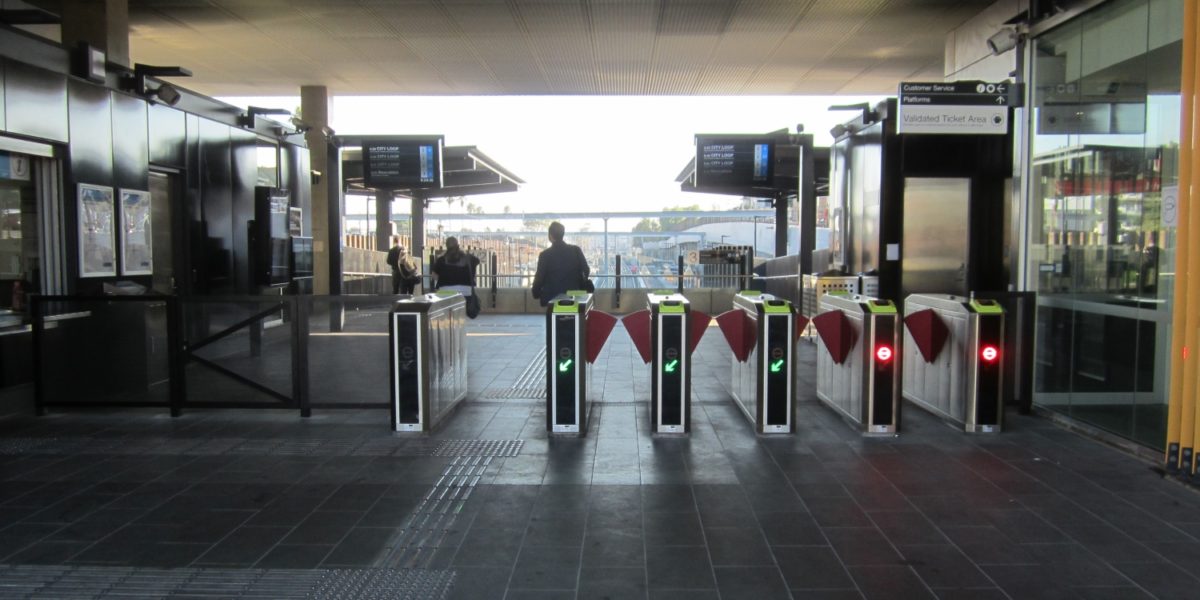
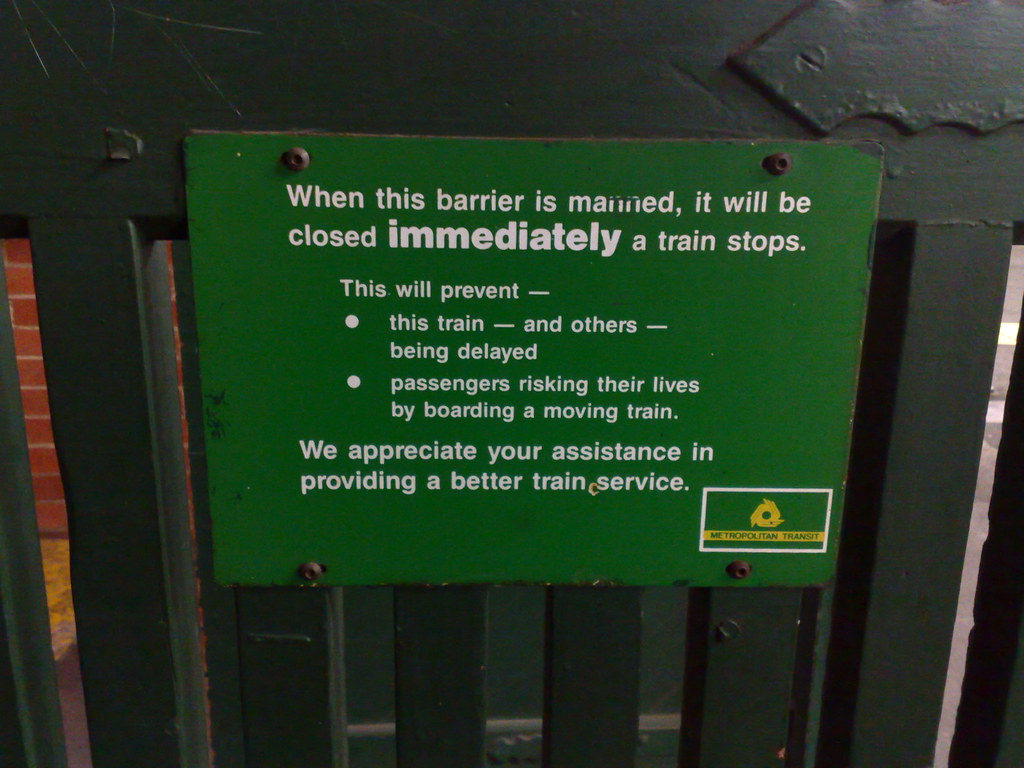
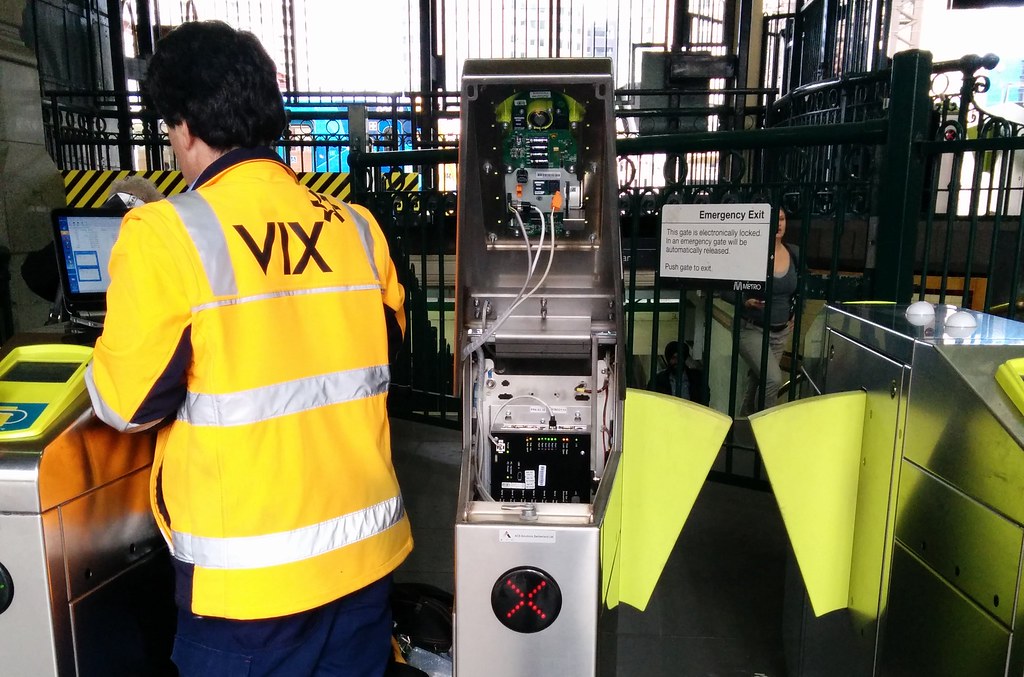
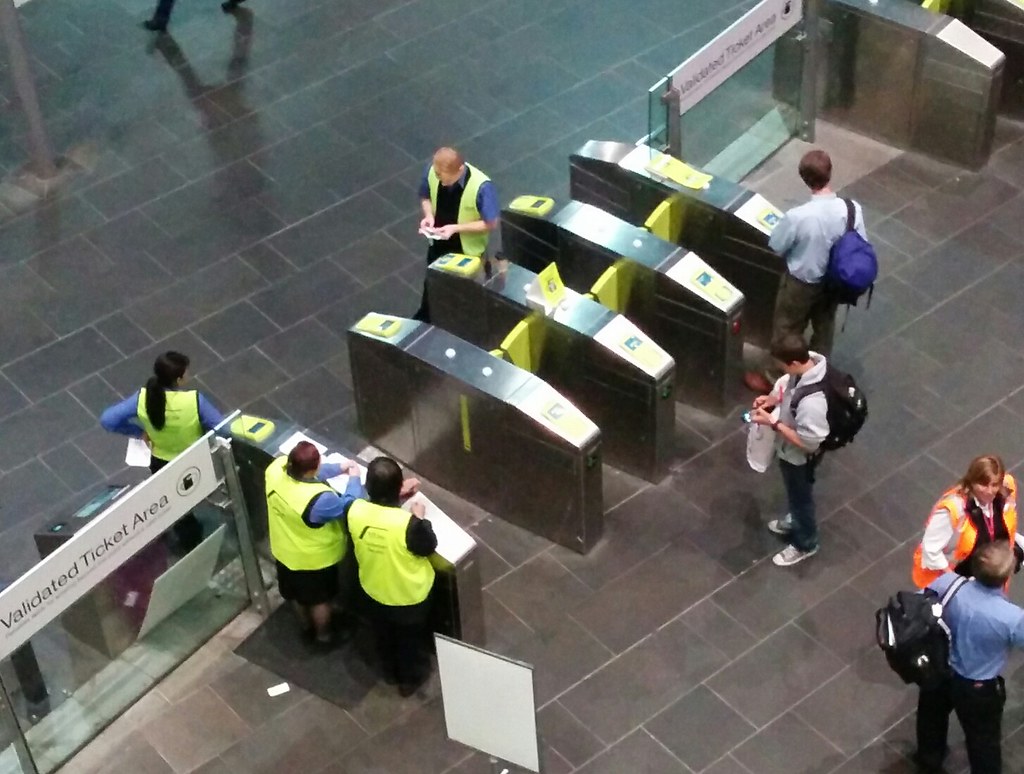

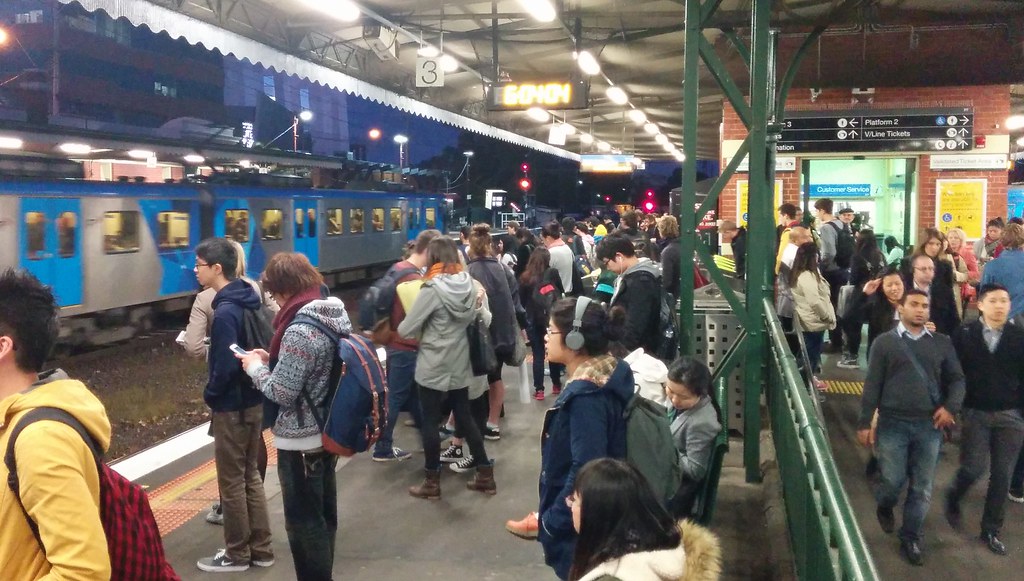
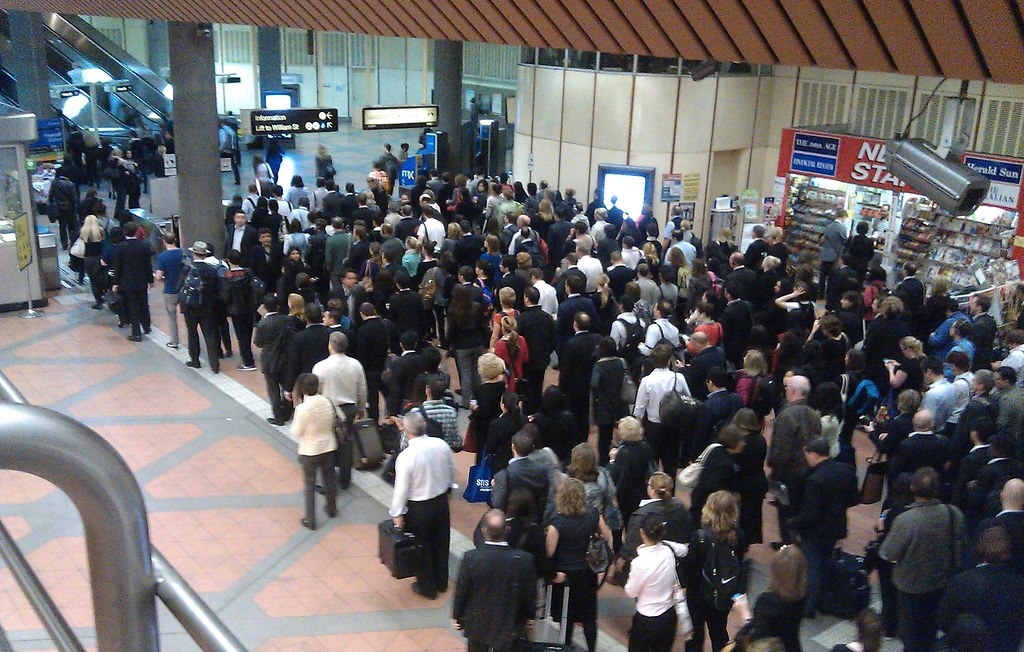
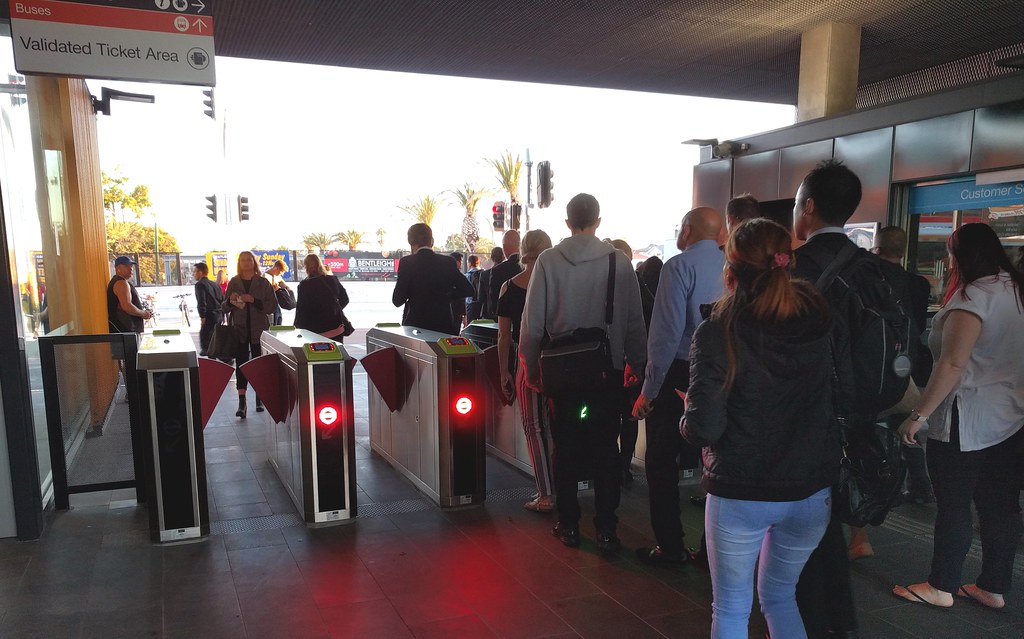
37 replies on “The ins and outs of fare gates”
You didn’t mention that ticket gates are not used at all in German speaking countries. This is because periodical tickets are widely used, plus random inspection by transit officers. I’ve never understood why Australian agencies blindly adopted inefficient U.K. practice.
Re: Flagstaff – the booking office hasn’t moved at all in recent years, with the current gate setup being the same as the late Metcard days.
As for locating booking offices adjacent to the gate, there have been some notable failures when building new stations: St Albans and Sunshine both have fare gates across the walkway from the booking office, forcing the provision of extra staff
And gate directions – since I’ve started taking a pram on the train, I’ve noticed many stations configure the wide gate to work in only one direction. This forces one to wait for barrier staff to open the wide gate from their end, while also requiring the user to touch on at a normal reader, confusing the gate software for the next person to come along.
Re suburb-to-suburb travel. Shows why the tunnel should not have been designed through the city, but rather, around it.
@Robin, it’d be interesting to compare compliance rates. We do know from PTV research that while the tram system has an open “Proof Of Payment” fare system, overall compliance is only slightly below that of the train system… noting however that the headline figure is overall compliance, and the rate of people who don’t have a ticket at all (No ticket + Runner) on trams is about double that of trains (October 2016 Fare Compliance report, page 9).
My concern is the confrontational nature of random inspections, at least as they are practiced in Melbourne. But I think it’s true that making monthly/yearly tickets cheaper (they are quite expensive by world standards) would help.
@Marcus, I had in my mind that Flagstaff’s booking office had been moved, but the photos don’t show that. Maybe it was earlier? The faster gates have made a big difference.
@Kevin, I don’t think it shows that at all. Suburb to suburb is higher than expected, but is still in the minority (23%), and many cross-suburban trips are still fastest when going via the city.
Another station with gates is Sunbury (platform 2 only), manned only during peak hour which makes sense as off-peak suburban trains mostly use platform 1, which has no gates.
Re: Caulfield pl4
It’d be interesting to see how many people are transferring from Dandenong bound to Frankston bound and vice versa in PM peak. There was an additional exit made available not long ago, but if it’s not being used much, this suggests a lot of people are trying to transfer rather than exit.
It’s probably nearly impossible in reality without careful timetabling of counter-peak trains, but I wonder if anyone has considered altering the AM/PM platform configuration at Caulfield to focus on making transfers easier and easing pressure on Myki gates.
AM: Pl 2/3 citybound (Frankston outbounds use Pl 1)
PM: Pl 2/3 outbound (Dandenong citybounds use Pl 4)
Somewhat related topic – Daniel, what are your thoughts on removing the fence down the centre of the Elizabeth St subway at Flinders Street station, and using the gates to cover the full width? People could touch on, walk through and touch off for free at the other end because of the 15-min turnaround, and it would provide more space for passengers changing platforms.
@Nick, it’s not really practical to reschedule trains at Caulfield as you’ve suggested, because it introduces too many conflicts. The station already handles something like a train every minute.
The ideal scenario would be to provide stopping-all-stations and express trains to both the Frankston and Dandenong lines, but that would require a flyover system at the eastern end of the station, quadruplication and resignalling works, and replacement of the Queens Avenue underpass with a horseshoe bridge (like Perth station) over the eastern end of the platforms, sacrificing the car parking both sides.
Ticket gate barriers have two major disadvantages – cost and impact on speed of egress. The cost of staffing ticket gate barriers is substantial and there are also maintenance costs. My experience of random inspection of Opal cards in Sydney is that the inspectors are surprisingly courteous and sensitive. In a city like Zurich, with very high levels of PT mode share and about 80% of riders have a periodical ticket, the problem of compliance almost disappears.
Sunshine also requires touching off through the gates and touching back on when transferring from a Metro train (in either direction) to a V/Line train – although that does give you a lower fare (as I’ve commented before). In fact, if I transfer from V/Line to Metro, I go out through the gates and then back in to save $1.36. And at Sunshine, the cafe kiosk is in the ticketed area, so if I want to get a coffee (if I’ve not caught the train to Sunshine) I go through the gates and then back out again before going to Platform 4.
Daniel, I don’t have much to add but I like your thorough and interesting to read analysis!
Pretty poorly managed gates at Glen Waverley too. Pre-Vix readers and minimal space for gates makes for long queues exiting at peak. Same goes for South Yarra at times. The new new widebody Vix readers I saw for the first time on a 96 tram are pretty darn good.
Thomastown
This article says that in 2015 on Berlin services run by the BVG (underground rail, buses, trams) almost 6% of the controlled passengers did not have a ticket, and on the S-Bahn (commuter rail) the rate was 4%.
http://www.tagesspiegel.de/berlin/oeffentlicher-nahverkehr-in-berlin-670-000-schwarzfahrer-erwischt/13044260.html
I’m not sure how you control for sampling affects to estimate the total amount of compliance. There must be statistics for other German cities, the search term to use is “Schwarzfahren”.
Thomastown station has gates on platform 1
@David Stosser
I’m generally happy with the segregated subway under Flinders Street station. It keeps the through pedestrian traffic flow separate from commuters. Otherwise I can imagine passengers wanting to change platform in a hurry crashing into unsuspecting walkers.
What could be improved though are the mid-subway ticket barriers that take up a bit more space than it should. If the middle barriers are removed, the fence could be made to be perfectly parallel to the side walls (with the ticket barriers moved to the ends of the subways). Surely people could make up their minds on whether they want to just walk through the subway or intend to go up to the trains before they enter the subway.
Also I don’t quite like the idea of everybody needing to possess the Myki with them just to walk through an otherwise free walkway.
Heatherdale needs gates now, or at least big reminder signs, but doesn’t have them. The walkway between the top of the stairs and the ticket readers is around 20 metres long, and the space between readers is quite wide as travellers approach an open, sheltered forecourt. It’s easy to forget to tap off when leaving the station because one can be walking quite quickly and at a significant lateral distance from a reader. Since it’s a Zone 2 station, there are travellers who need to tap off to be charged the lower Zone 2 fare.
@David – making the Flinders Street Station subway paid only. Roma Street Station does just this, with ticket gates at both ends, and barrier staff letting the public without tickets through to the parkland at the north end, or to the long distance train platform 10.
In HK they swapped the line levels in a 4 track underground station (was in Wanchai, Central or Admirality, not sure) so they could get cross platform transfers between lines and avoid commuters rushing up and down escalators, etc. AND the trains arrive sufficiently frequently to facilitate this. Brilliant, but way to hard for Australian PT planners I suspect.
They could speed up the Caulfield platform 4 exit (I do the transfer to Frankston almost daily) in two simple ways:
1) get rid of that green wooden upright in the middle of the exit. It isn’t even lined up with the readers. Is it heritage listed?
2) explain properly to people that they don’t need to touch off there. I never do. And yes you can touch on again on platform 2 without touching off.
Gates would also be quicker if people would touch through when the screen said they could instead of waiting for the paddles to close. You can keep the gate open permanently, on both styles if reader, if you keep on scanning.
Why not put the fare gates at either side of the subway at Caulfield. So passengers can interchange directly bettween all four platforms. All they would need to do is put in prefabricated ticket office in at both sides and a little bit of rain cover.
@Jess Chrimes,
Fare gates either side of the subway wouldn’t work. It is possible that is may work on the racecourse side, as the footpath is very wide, but on the Uni side the footpath is very narrow and I doubt there is enough room to add gates in. I would prefer to:
a) have gates at the entry/exit to platforms 1 & 4
b) Have additional entry/exit points (e.g. Platform 1 next to car park), and
c) An overpass on one or both ends to allow interchange without exiting the station.
On another point, why at stations without gates are the Myki readers at the platform entrances. It seems to me to make more sense to have multiple myki readers up and down the platform, which I think would reduce crowding at the platform entrances. It would also limit one of the problems I see when exiting at Glen Huntly, where people rushing to get the train often miss it because of the large crowds trying to exit and use the same myki readers at the same time.
Travelling from Broadmeadows to Frankston, I encounter persistent difficulties with the gates at Frankston. The gate rejects my card, even though it works everywhere else and has plenty of credit.
Someone told me it might be because the journey took longer than 2 hours, but that would be ridiculous…
enno, the two hour issue is very true. It is a dumb feature to have, but that is how the system works. Try missing a train on the Geelong line, and go all the way to Waurn Ponds or back. I have had the same problem there.
Re the gates issue. On various places such as Caulfield #1 and #4, we need to go back to having the gates locked while a train is in the platform. Just have the gates set to lock close when a train is there.
Daniel – a terrific article, as ever.
What you perhaps fail to realise is that Metro barrier staff are not there to monitor fare compliance. On the contrary: they are under strict instructions to let through anyone who requests it, whether the person is in possession of a valid ticket or not. Only authorised officers, who are rarely present, are allowed to check tickets.
As implemented, the barriers serve no useful purpose. Hopefully one day this will change.
I think Oakleigh station also has gates.
I use Hughesdale, South Yarra, Prahran and Caulfield quite regularly.
The Caulfield issue is a real pain – not so bad if you are swapping between platforms 1 and 4 but worse if you are getting off at the middle platforms and transferring to 1 (e.g to go the whole 1 stop to Malvern).
Another issue is that the arrangement of gates, walkways and ticket booths often means that queues are blocking smooth movement of passengers. This has been a real issue at South Yarra in the past, though it is now a little better. And something that really bugs me is when station staff or inspectors, and often people giving away promotional items, get in the way of the passengers moving through station entries.
Another whinge – sometimes there is such a massive exodus of passengers from a train at South Yarra that I can’t get through the crowd coming up the ramp to get on my train. I think the ramps and walkways almost need lanes now to separate those boarding and disembarking.
Caulfield, like South Yarra, needs a new/second concourse. Lots of people interchange there as well as lots of people getting on or off and the queues can be quite long and it can be crowded at busy times.
The (relatively) new second entrance/exit between platform 4 and Sir John Monash Drive has helped platform 4.
This is only set to be much worse with the new tunnel.
The new concourse should allow transfer without leaving the paid area.
The Queens Avenue end of the station looks to have more space for a new concourse, although this may requires the relatively new cafe building to be demolished.
You missed Sunbury(Platform 2 Only)
Well on the bus, it insists that I am actually tagging on, although I am tagging off. And then, the next time I travel, I get a default fare. Oh well.
But on the station with the gates, the gate doesn’t open. I get “card declined, call 1300xxxyyy”. I don’t know if it is the 2 hour problem, or run out of credit, or the card RFID physically defective, or what. It’s just BS, and I am not going to make an expensive and probably inconclusive call to discuss it with them.
Is it, or is it not, legal on Melbourne’s system, to travel by train from Broadmeadows to Frankston ? It’s a pretty simple question! If it takes more than 2 hours, then OK, go ahead and charge a daily fare, if that’s how it has to work. But to lock the gate closed and demand that I call them, that’s just BS.
@ange — Oakleigh has no gates, just Myki readers at the chokepoints to go from platform 1 and 2 down the ramp to the underpass, and on the lesser-user platform 3 to go through the station building
@Ange
As Adrian said, Oakleigh has no gates. The way the station’s currently designed, one could at best put three gates on each side for the main island platform, and maybe four for the lesser used platform 3. It probably needs to be rebuilt before that will happen, the station’s starting to fall to pieces and a lot of the art that used to be there is decaying or has been removed.
@Martin
Oakleigh’s platform 2 has these extra myki readers, but unfortunately very few people use them. I’m often one of at best a dozen people who touch off using them, while the other thirty or so departees gather around the four readers at the chokepoint near the underpass entrance.
Caulfield will probably need some kind of enormous redesign at some point; South Yarra too. What with the new Dandenong stations and skyrail supposedly being designed for quadruplication, they’ll need space for the extra platforms somewhere.
[…] the fare gates in the Campbell Arcade underneath Flinders Street Station seemed to be left open a lot of the time. […]
[…] flip side of that sign shows train departures as you enter. There are eight fare gates, and it was good to see that on a quiet New Years Day afternoon, these were closed and staffed […]
With the size of the fine you only really have to catch fare evaders a small percentage of the time. Transperth certainly seems to do a good job of it.